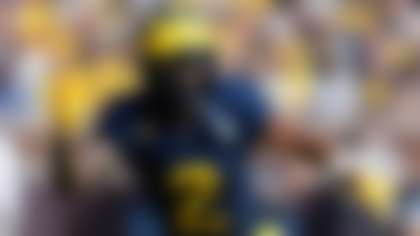The goal for each NFL club on draft weekend is to take this inexact science and spin it as much as possible into an exact one. Each draft's paramount core -- selecting the correct players to match coaching style and scheme, projecting which ones will blossom in the pro game, discerning those who have an innate and enduring passion for the game -- is a tricky business.
A handful of selectors in this league arrive equipped with cape and wand more than others.
The best draft selectors employ an army behind them, a group of foot soldiers who year-round travel to remote places -- as well as to storied college towns -- to compile reports on players. The best selectors work with that team, with their in-house draft personnel and with their coaches to mull every fragment of data, to rank every player available.
It is, indeed, a team effort.
And then someone has to make the call.
Someone has to decide the name that is written on the card that is delivered to and announced at the NFL draft-day podium.
These are the top five draft selectors in the 2009 NFL Draft. Not only do NFL fans yearn to see what decisions this group of five will make this weekend, but so do these men's peers across the league. Their prior drafts have been studied by their peers and some have emulated portions of their approach after this group.
Their 2009 draft will provide one more intriguing case study.
1. Bill Belichick, New England Patriots head coach
Belichick is one of only four coaches to win three or more Super Bowls (Chuck Noll, Bill Walsh and Joe Gibbs are the others). Gibbs of this group makes this point very clear -- it's all about the players. Sure, it's about the coaching, too, but it's primarily about the players. Throughout his draft history with the Patriots, Belichick has drafted with an unmistakable confidence that most often has turned into results. His players fit his systems and his systems fit his players. He works this draft without his longtime personnel aficionado Scott Pioli by his side, since Pioli is Kansas City's new general manager. Few expect Belichick to miss a beat. As one NFL personnel executive said: "This guy has the final say and uses it well. He can make what looks like a ridiculous pick and people around the league will start to scramble, analyze it and wonder if they missed something, because, usually, it's not so ridiculous if he made it. His success breeds that." Belichick's skill for identifying and gathering players who have robust passion for the game is second to none.
2. Bill Polian, Indianapolis Colts president
Polian is all business when it comes to the draft and uses wide-spread football knowledge in his craft of drafting. He does not lock himself into hard and fast rules but tends to lock in on one primary thing -- either the guy is a good football player or he is not. Take his selection of safety Bob Sanders in the second round of 2004. Not a prototypical size at safety. Actually, Sanders appeared awfully small -- though compact -- and looked like a role player when exiting Iowa. But Polian saw a dynamite football player. He often, correctly, does. He has a natural eye for this art of drafting, a splendid knack.
3. Jerry Reese, New York Giants senior vice president & general manager
Though Reese is commanding only his third draft, his first two caught attention around the league and put all on notice -- this guy is good. Schooled under veteran personnel guru Ernie Accorsi, Reese's entire draft class from his first season contributed in meaningful ways to the GiantsSuper Bowl XLII championship run. A league personnel expert added: "He took the tight end Kevin Boss in that draft from Oregon and that is a player that would have sat for some time on most teams and a guy that most of us just didn't think would translate into much of an NFL player. But they developed him enough into becoming a starter and traded Jeremy Shockey and now that kid has a chance to become a staple for them." Reese works in conjunction with his coach, Tom Coughlin, to get young players on the field. That is not always the case in the NFL, since some coaches insists upon experience over youth. Reese never minimizes production at the college level. He routinely follows an old-school draft axiom: The player who is putting up numbers in Pee Wee League is the player who puts up numbers in high school who is the player who puts up numbers in college and likely will be the player who puts up numbers in the NFL.
4. Bill Parcells, Miami Dolphins executive vice president - football opperations
No one finds tough, hard-nosed football players in bushels like Parcells does and no one is willing to discard mistakes as quickly as Parcells does. His conviction and confidence in his selections help make him a pro's pro in the draft. Parcells finds coachable players and decides how much rope they will get, especially early in their careers. His understanding of what makes superior linemen on both sides of the ball is keen and he knows how to mix and match his roster from top to bottom into one complementing piece.
5. Ozzie Newsome, Baltimore Ravens general manager & executive vice president
Newsome is not as concerned with numbers -- 40-times, bench presses, shuttle drills -- as he is with finding players his coaches can mold and fit into his big picture. That big picture means complementing weapons on offense, defense and special teams. Newsome drafts to supplant all three areas, and little wonder the Ravens -- more than most NFL teams -- feature such balance. Especially now, with last year's drafting of Joe Flacco at quarterback to solve a lingering piece of his puzzle. An NFL personnel executive said: "A lot of people in last year's draft were not sold at all on Flacco and they take this guy and coach the heck out of him and went a long way." Among this group of five, Newsome is the lone member of the Pro Football Hall of Fame. He was a unique talent. He knows one when he sees one.



